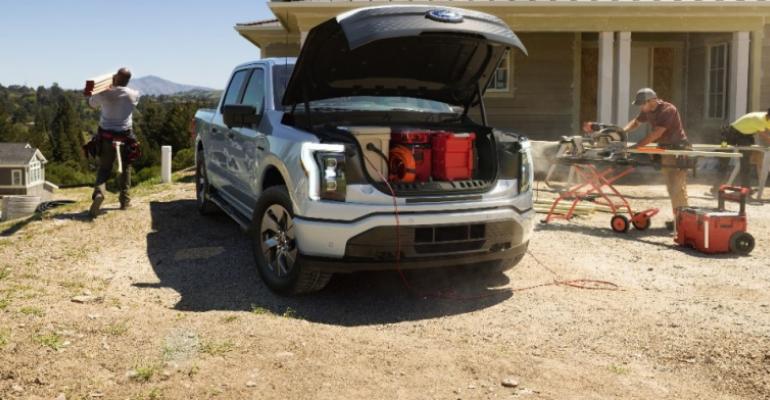Ford is pushing electrification into high gear and now expects battery-electric vehicles to represent 40% of the automaker’s global vehicle sales by 2030.
During the automaker’s Capital Markets Day presentation today on “Delivering Ford Plus,” CEO Jim Farley says Ford will boost spending on electrification to more than $30 billion by 2025, including development of IonBoost batteries. In April, executives said Ford expected to spend $22 billion on various electrification initiatives.
“We don’t underestimate the challenge,” says Farley of shifting consumers into electric vehicles. “We’re not going to wait for the government to change peoples’ minds. We’re going to do that ourselves,” he says, by offering compelling digital products aimed at both retail and commercial customers.
The objective, Farley says, is to break away from the “transactional, build-and-sell business model” that has typified the auto industry for decades.
Ford Plus will build on the company’s enduring relationships with customers – and dealers – while enabling the company’s basic strengths, improving financial performance and investments in disruptive technologies to take hold, Ford officials say. Farley notes the company already has collected $100 deposits from 70,000 customers interested in the F-150 Lighting.
“I’m excited about what Ford+ means for our customers, who will get new and better experiences by pairing our iconic, world-class vehicles with connected technology that constantly gets better over time,” Farley says.
“We will deliver lower costs, stronger loyalty and greater returns across all our customers. This is our biggest opportunity for growth and value creation since Henry Ford started to scale the Model T.”
Farley says the new strategy will lean heavily on the strength of its commercial business in North America and Europe, where it leads the commercial segment. The automaker is creating “Ford Pro” as a standalone company with its own chief executive and a focus on vehicle service and productivity requirements of commercial and government customers.
“We’re creating a one-stop shop to help those customers increase uptime and productivity while reducing complexity and the total cost of ownership,” adds Farley, noting Ford already services 125,000 fleet customers in North America.
Ford Pro’s assets will include a full range of F-Series and Ranger trucks, as well as Transit, the world’s best-selling cargo van.
In the U.S. it will have a network of 600 service centers geared to the commercial business and 300 upfitters that specialize in modifying production vehicles for commercial use as well as a growing fleet of vans for servicing vehicles.

Ford Pro will be led by Ted Cannis as CEO. Cannis currently heads Ford’s North America CV business.
Ford has plans for high-volume electric vehicles, including the E-Transit later this year and the F-150 Lightning Pro in mid-2022, which Ford Pro will pair with commercially focused charging solutions. Ford Motor Credit is expected to work more closely with Ford Pro to provide customers greater access to financing.
Ford Pro’s plans are ambitious. The spinoff company anticipates generating $45 billion in revenue from hardware and services by 2025, up from $27 billion in 2019, Farley says.
In North America, Ford’s share of Class 1 through Class 7 fullsize trucks and vans today exceeds 40%. In Europe, Ford has been the leading commercial-vehicle brand for six consecutive years, he adds.
In the future, Ford, through what the company is calling BlueOval Intelligence, will rely more on connected services for which customers pay separately through individual subscriptions.
The goal is to capitalize on what could grow to be a $20 billion market for such services by 2030, Farley says.
The system will allow for over-the-air vehicle software updates and more personalized service.
Farley notes Ford will have 1 million vehicles capable of receiving OTA updates on the road by the end of this year, exceeding Tesla’s volume by July 2022, and scaling to 33 million OTA-enabled Ford and Lincoln vehicles by 2028.
The new systems bolster customer relationships with digitally enabled tools such as FordPass and Lincoln Way, online ordering, simplified financing and renewal options, vehicle pick-up and delivery, and mobile repairs.
John Lawler, Ford’s chief financial officer, says the enhanced connected data will help detect and resolve quality issues, raise customer satisfaction and lower warranty costs.
Warranty costs have hurt Ford’s financial performance in recent years but are steadily improving as the company makes progress on its goal to deliver an 8% profit margin before interest and taxes.





